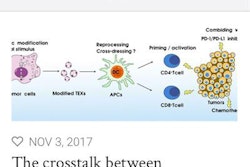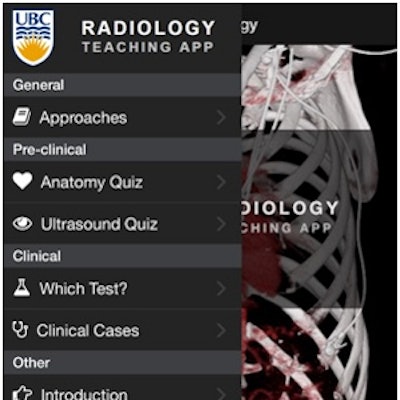
AuntMinnie.com presents the next article in an ongoing series highlighting notable mobile apps in radiology. In this installment, we take a look at the UBC Radiology teaching app, an iOS and Android app developed by a group from the University of British Columbia (UBC). Targeted primarily at medical students, the app is designed to serve as a standalone undergraduate radiology curriculum.
To learn more about the UBC Radiology teaching app, we chatted with Dr. Kathryn Darras, project lead for the app and a nuclear medicine fellow at UBC.
AuntMinnie: What inspired you to create this app? What problem does it help solve?
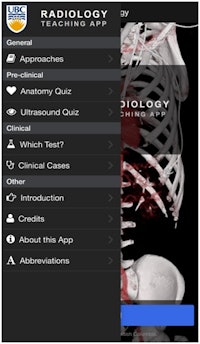 Content in the UBC Radiology teaching app is divided into preclinical and clinical sections. All images courtesy of Dr. Kathryn Darras.
Content in the UBC Radiology teaching app is divided into preclinical and clinical sections. All images courtesy of Dr. Kathryn Darras.Darras: Although radiology has become the cornerstone of modern medicine, medical schools have not adjusted their curricula to include radiology as a core subject. Our team believes that this is partly because educators struggle to find high-quality, evidence-based resources to recommend to undifferentiated medical students. This app seeks to solve this issue by providing an innovative resource that combines validated pedagogical approaches as well as cutting-edge technology. It's designed not only to teach students to recognize basic imaging findings, but also to teach the principles of imaging appropriateness and to provide students with a better understanding of the role of the radiologist in patient care.
Who is the target audience, and how do you envision the app will be used?
This app is designed as a standalone undergraduate radiology curriculum to be used by radiologists in teaching, and its target audience is primarily medical students. The app is based on standardized objectives from the Association of University Radiologists and the European Society of Radiology and therefore is designed to integrate into any medical undergraduate curricula worldwide. Using validated pedagogy, the content is organized to follow medical students from their first day of medical school to their first day of residency and beyond.
The app is arranged into two main sections: preclinical (MS1, MS2), which focuses on anatomy and ultrasound, and clinical (MS3, MS4, intern), which focuses on ordering imaging and clinical cases. The curriculum includes over 500 anatomy questions featuring x-ray, CT, MRI, and ultrasound images; over 60 fully worked clinical cases; and a quiz designed to teach imaging appropriateness.
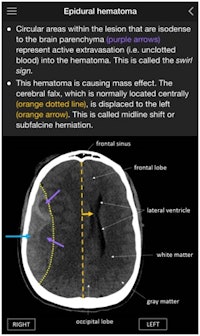 Screenshot of a clinical case (epidural hematoma) included in the app.
Screenshot of a clinical case (epidural hematoma) included in the app.The clinical cases include scrollable datasets and detailed case descriptions, which include the differential diagnosis, diagnosis, and findings. The clinical details of the cases are very vivid, and each case contains a "Clinical Pearls" section to relate the imaging to real patient cases. Currently, the app is integrated into the medical undergraduate curriculum at our institution, the University of British Columbia.
What are the app's most important features?
The app has several important features that make it truly unique. First, it was designed with input from medical students with a wide range of career goals. Prior to app development, students were asked in an anonymous survey which pedagogical and technical elements they felt would be most valuable to their learning. All of their feedback and suggestions were taken into account while developing this resource to ensure that it was in line with the needs of current learners.
Second, the app is available on both iOS and Android platforms for free. It was very important to us that this resource be open-source in order to engage students in the specialty. This was made possible thanks to a University of British Columbia Teaching and Learning Enhancement Fund grant.
The app also includes radiology-pathology correlation in the clinical cases section. This feature allows students to link to what they are learning in radiology to other disciplines, like surgery and pathology.
How many users do you currently have for the app?
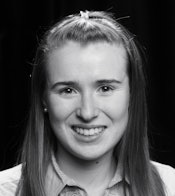 Dr. Kathryn Darras, project lead for the app and a nuclear medicine fellow at UBC
Dr. Kathryn Darras, project lead for the app and a nuclear medicine fellow at UBCThe app has been available since November 2016, and there are just over 22,000 users from around the world. The majority of these downloads are on the Android platform.
What are your future plans for the app? Are there any new features or content in the works?
We are constantly updating and renewing our content based on learner feedback. Right now we are working on expanding the radiology-pathology feature in the app.
In addition, we want to study the educational impact of this app in medical schools. We are currently evaluating students' use of the app as an innovative and disruptive educational technology in preclinical anatomy teaching at our institution. The app appears to allow for learning opportunities that aren't possible with online modules or textbooks, and we would like to explore this further. Part of our early research will be presented this year at RSNA 2017.
Do you plan to develop any other apps?
Definitely! Our team is interested in exploring the intersection between pedagogy and technology in undergraduate radiology education and we have plans to develop at least one more app in this space.
The UBC Radiology teaching app can be downloaded for free from the iTunes Store and Google Play. Other key members of the UBC team included software engineer Dr. Matthew Toom, a second-year family practice resident; faculty supervisor Dr. Savvas Nicolaou, a professor and vice chair of undergraduate education in the department of radiology; and faculty sponsor Dr. Bruce Forster, a professor and head of radiology.








